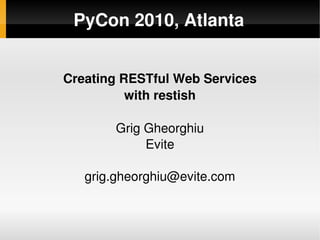
PyCon 2010 REST Talk
- 1. PyCon 2010, Atlanta Creating RESTful Web Services with restish Grig Gheorghiu Evite grig.gheorghiu@evite.com
- 2. Credits Roy Fielding Ph.D. Dissertation 'RESTful Web Services' book by L. Richardson and S. Ruby (O'Reilly) Joe Gregorio's REST articles for xml.com Mark Pilgrim's Web services tutorial in 'Dive into Python' Mark Nottingham's Web caching tutorials
- 3. What is a web service? Specific kind of Web application Consumed by applications, not directly by humans/browsers Typically emits XML or JSON and not HTML Examples: Amazon Web Services (S3, SQS, EC2), Yahoo Web Services (del.icio.us, Flickr) 'Programmable Web': http://www.programmableweb.com/apis/directory/
- 4. What is REST? ”REpresentational StateTransfer”: Roy Fielding, Ph.D. Dissertation, UC Irvine, 2000 'Architectural style for distributed hypermedia systems'; start with NULL style and add constraints: ClientServer Stateless Cache Uniform Interface Layered System
- 5. HTTP crash course Requests and responses HTTP request: a method (GET, POST, PUT, DELETE, HEAD), a path (/index.html), a set of headers, and the entitybody (representation) HTTP response: a response code (200, 404, etc.), a set of headers, and the entitybody (representation) Lingua franca of the Internet
- 6. Web architectures REST(ful) Based on HTTP methods (GET, POST, PUT, DELETE) Arguments to methods go in URIs or in HTTP payloads Amazon S3, last.fm API RPCstyle (SOAP, XMLRPC) Typically one single URI is exposed Heavy on POST operations Hybrid RESTRPC Overloaded GET used to modify data Bad idea (remember Google Web Accelerator?)
- 7. ResourceOriented Architecture Leonard Richardson and Sam Ruby 4 concepts: resources, their names, their representations, the links between them 4 properties: addressability, statelessnes, connectedness, uniform interface
- 8. Resources and URIs Resource == anything that is important enough to be referenced (or linked to) Comparable to objects in OO design Every resource has a 'name': URI == Uniform Resource Identifier 1 resource → N URIs Examples of URIs: URL(ocator): http://socalpiggies.org/scp URN(ame): urn:isbn:0395363411
- 9. Representations and links Representation == concrete data which describes the current state of a resource Example: description of the most recent bug In practice: a specific data format (XML, JSON, etc) Clientserver state transfer happens by exchange of representations (hence ”REpresentational State Transfer”) Server guides client from one state to another by means of links embedded in representations
- 10. Addressability Resources exposed as URIs are addressable Can be linked to Can be bookmarked Can be printed in a book Can be sent in an email Can be cached Openness vs. Opacity; REST vs. RPC Think 'mashups'!
- 11. Statelessness Each HTTP request contains all the state it needs for the server to fulfil it State is only on the client side! Server can nudge client to different states via links (connectedness) Statelessness induces: Visibility: each request can be monitored in isolation Reliability: easier to recover from partial failures Scalability: easy to scale horizontally
- 12. The Uniform Interface Methods dictated by HTTP verbs (uniformity) uniformity CRUD operations Create: POST/PUT Retrieve: GET (HEAD for resource metadata) Update: PUT Delete: DELETE GET and HEAD should be safe (no changes to server state) GET, HEAD, PUT should be idempotent
- 13. So...why REST? ClientServer (Web client ↔ Web server) Stateless (client keeps state) Uniform interface (HTTP methods) Caching Reduces latency Reduces network bandwidth Layered system (higher application layer calls lower Web services layer)
- 14. HTTP caching in a nutshell Special HTTP headers Server: freshness indicators (”it's safe to cache”) Cachecontrol → absolute date/time Expires → delta relative to time of request Server: validators (”is it still safe to cache?”) LastModified → absolute date/time Etag → hash of content Client: IfModifiedSince (for LastModified) Client: IfNoneMatch (for Etag)
- 15. Creating a RESTful service Joe Gregorio article ”How to create a REST protocol” To create a REST service, you need to answer the following questions, and you should answer them in this order: What are the URIs? (resources) What's the format? (representations) What methods are supported at each URI? What status codes could be returned?
- 16. Introducing the restish framework Created by Tim Parkin and Matt Goodall Part of the 'ish' family of tools at http://github.com/ish Formish Adminish Couchish Example site developed with restish: www.profiled.com
- 17. Why restish? Closetothemetal, RESToriented, WSGI aware Well tested and powerful URL handling, parsing and creation Powerful but simple HTTP request and response handling (based on WebOb) Simple integration with templating frameworks (mako, jinja2, genshi, django) Basic HTTP auth via guard module (e.g. using repoze.who as WSGI middleware)
- 18. Demo app: todoish list mgmt What are the URIs? (resources) /lists/LISTID/items/ITEMID What's the format? (representations) JSON What methods are supported at each URI? POST, PUT, GET What status codes could be returned? Success: 200 OK, 201 Created Error: 404 Not Found, 501 Not Implemented
- 19. Consuming Web services Curl curl -i -X POST 127.0.0.1:9999/lists/ -H "Content- Type: application/json" -d '{"name":"new list"}' Httplib2
- 20. Testing a restish Web app Unit testing: WebTest Functional testing: twill (for HTML representations)
- 21. Deploying a restish Web app Run web application process properly as a daemon (e.g. using grizzled.os) Use log rotation (rotatelogs, scribe) Use automated deployment tools (fabric) Use robust reverse proxy/load balancer (e.g. nginx)
- 22. What should you take away? blah blah blah RESOURCES blah blah blah HTTP UNIFORM INTERFACE blah blah STATELESSNESS blah blah JSON/XML blah blah RESTISH blah blah TESTING blah blah AUTOMATED DEPLOYMENTS blah blah EVITE IS HIRING PYTHON PROGRAMMERS